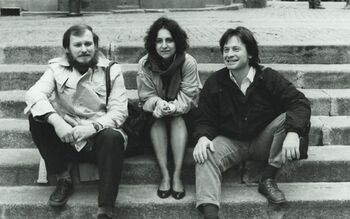Bcd
BCD cybernetic art team – has been working together since 1971 in the field of cybernetic art, design and science.
Members: Vladimir Bonacic (artist and cyberneticien), Miro A. Cimerman (software designer) and Dunja Donassy (architect and city planner).
The problem of intersubjective communication is essential. It is the fundamental aim towards which every computer user should be striving, so that the technology which is available and developing today will help advance human freedom and not subject it to new forms of alienation.
The team performs simultaneously scientific and artistic research as part of a single goal, which is to bring together two worlds. In 1972 they established the Jerusalem Programme in Art & Science. It was set out as an internationally oriented interdisciplinary research and study to bridge the gaps between institutions of higher learning, dealing primarily with either art or science. The interest of the programme combined ethics, the sociology of art and science, hidden data structures, cybernetic art, dynamic lighting of the environment and some aspects of computer-aided design.
In their work BCD mainly explored the algebraic structures called Galois-Fields, named after French humanist and mathematician Evariste Galois (1811-1832). Artwork reveals the existence of hidden variables.
In 1980 they settled in Germany, where they continued to work in the field of cybernetic art, parallel processing, pattern recognition, communication design and real time imaging. Their work was used by the media when presenting socio-political sciences.
Their focus was always the bridge between art and science and the impact of technology on the information society.
The BCD cybernetic art team has been working together since 1971 in the field of cybernetic and computer art, design, and science.
In a somewhat Romantic view of technology, but rather typical for the time, the group subscribed to the advancement of freedom through ever improved communication, and that communication would greatly be improved by information technology. Perhaps, they were not so wrong.
The team was certainly among the early believers in the necessity of doing both scientific and artistic research in parallel as part of the pursuit of a single goal. This goal could only be to bring together the two worlds.
In 1972, they established the Jerusalem Programme in Art & Science. It was set out as an internationally oriented interdisciplinary research and study to bridge the gaps between institutions of higher learning, dealing primarily with either art or science. The programme aimed at combining ethics, sociology of art and science, hidden data structures, cybernetic art, dynamic lighting of the environment, and aspects of computer-aided design.
In an important part of their work, BCD explored the algebraic structures of Galois-Fields, named after the French humanist and mathematician, Evariste Galois (1811-1832). They did this from a position requiring that a work of art must reveal the existence of hidden variables. Galois-Fields seemed just to be the right method to achieve this.
In 1980, they settled near Bonn in Germany, where they continued to work in the field of cybernetic art, parallel processing, pattern recognition, communication design, and real time imaging. Their work was widely used by the traditional media to present socio-political facts and relations (as, e.g., the results of an election).
(adopted from http://www.mediascape.info/2010/participants/part1.htm)
- Articles
- Raymond Daudel, "The Cybernetic Art of the bcd Team", Visions for Cybernetic Art, exhib. cat., Paris Art Center, Académie Européenne des sciences, des arts et des lettres, Paris, 1987, n. p.
- Links
- Margit Rosen, Dunja Donassy-Bonačić, Miro A. Cimerman, "Vladimir Bonačić & bcd CyberneticArt team: CyberneticArt", Karlsruhe: ZKM, 2019, 73 min. Video. Event. (German)
- bcd at Vintage Computer Festival Berlin, 2020, 2021
